Event-Triggered Ephemeral Group Communication and Coordination over Sound for Smart Consumer Devices
Abstract
1. Introduction
- Having the motivating real-world problem, that is, the uncoordinated reaction of today’s voice-enabled consumer devices (in Section 2.1), we present the framework solution tailtag, which employs the sound-based data communication tailored to the problem (in Section 3).
- We introduce the adaptive messaging scheme, considering the inherent restriction of sound for data transmission. This enables expediting the message transmission of high significance and suppressing the unnecessary message transmission, hence providing a reliable solution to our specific time-constrained leader election problem (in Section 3.3).
- We conducted simulation experiments under various environmental conditions, demonstrating that the framework adoption is able to meet the requirement of the real application scenarios, such as 98% accuracy for the Bixby hotword case, where the accuracy was measured based on the rate that, within the given latency bound, a single (non-redundant) response among multiple Bixby-enabled smartphones is appropriately made (in Section 4).
2. Background
2.1. Motivation
2.2. Sound-Based Data Communication
3. Framework Design
3.1. Overall System
| Algorithm 1 handleEvent. |
| OUTPUT: whether or not respond On event e:
On message m from channel :
On timer expiration :
|
3.2. Framework Parameter Derivation
3.3. Adaptive Parameters
4. Evaluations
4.1. Algorithm Comparison
4.2. Tailtag Adoption
5. Related Work
6. Conclusions
Author Contributions
Funding
Conflicts of Interest
References
- Google Assistant. Available online: https://assistant.google.com/platforms/speakers/ (accessed on 25 February 2019).
- Samsung Family Hub. Available online: https://www.samsung.com/us/explore/family-hub-refrigerator/overview/ (accessed on 25 February 2019).
- Voice Assistant Market Research Report. Available online: https://www.marketresearchfuture.com/reports/voice-assistant-market-4003 (accessed on 25 February 2019).
- Bixby Developer Day. Available online: http://bixbydeveloperday.developer.samsung.com/ (accessed on 25 February 2019).
- Snowboy Hotword Detection. Available online: https://snowboy.kitt.ai/ (accessed on 25 February 2019).
- Google Home. Available online: https://support.google.com/googlehome/answer/7257763?hl=en&co=GENIE.Platform=Android (accessed on 25 February 2019).
- Medeiros, H.; Park, J.; Kak, A. A Light-weight event-driven protocol for sensor clustering in wireless camera networks. In Proceedings of the 2007 First ACM/IEEE International Conference on Distributed Smart Cameras, Vienna, Austria, 25–28 September 2007; pp. 203–210. [Google Scholar]
- Medeiros, H.; Park, J.; Kak, A. Distributed object tracking using a cluster-based kalman filter in wireless camera networks. IEEE J. Sel. Top. Signal Process. 2008, 2, 448–463. [Google Scholar] [CrossRef]
- De San Bernabé, A.; Martinez-de Dios, J.; Ollero, A. Entropy-aware cluster-based object tracking for camera wireless sensor networks. In Proceedings of the 2012 IEEE/RSJ International Conference on Intelligent Robots and Systems, Vilamoura, Portugal, 7–12 October 2012; pp. 3985–3992. [Google Scholar]
- Iannucci, P.A.; Netravali, R.; Goyal, A.K.; Balakrishnan, H. Room-Area Networks. In Proceedings of the ACM Workshop on Hot Topics in Networks, Philadelphia, PA, USA, 16–17 November 2015; pp. 9:1–9:7. [Google Scholar]
- Awerbuch, B. Optimal distributed algorithms for minimum weight spanning tree, counting, leader election, and related problems. In Proceedings of the ACM Symposium on Theory of Computing, New York, NY, USA, 25–27 May 1987; pp. 230–240. [Google Scholar]
- Frederickson, G.N.; Lynch, N.A. The impact of synchronous communication on the problem of electing a leader in a ring. In Proceedings of the ACM Symposium on Theory of Computing, Washington, DC, USA, 30 April–2 May 1984; pp. 493–503. [Google Scholar]
- Garcia-Molina, H. Elections in a distributed computing system. IEEE Trans. Comput. 1982, 1, 48–59. [Google Scholar] [CrossRef]
- Malpani, N.; Welch, J.L.; Vaidya, N. Leader election algorithms for mobile ad hoc networks. In Proceedings of the Workshop on Discrete Algorithms and Methods for Mobile Computing and Communications, Boston, MA, USA, 11 August 2000; pp. 96–103. [Google Scholar]
- Dong, Q.; Liu, D. Resilient cluster leader election for wireless sensor networks. In Proceedings of the IEEE Communications Society Conference on Sensor, Mesh and Ad Hoc Communications and Networks, Rome, Italy, 22–26 June 2009; pp. 1–9. [Google Scholar]
- Rahman, M.M.; Nahar, A. Modified bully algorithm using election commission. arXiv 2010, arXiv:1010.1812. [Google Scholar]
- Zandbergen, P.A.; Barbeau, S.J. Positional accuracy of assisted GPS data from high-sensitivity GPS-enabled mobile phones. J. Navig. 2011, 64, 381–399. [Google Scholar] [CrossRef]
- Zegeye, W.K.; Amsalu, S.B.; Astatke, Y.; Moazzami, F. WiFi RSS fingerprinting indoor localization for mobile devices. In Proceedings of the 2016 IEEE 7th Annual Ubiquitous Computing, Electronics & Mobile Communication Conference (UEMCON), New York, NY, USA, 20–22 October 2016; pp. 1–6. [Google Scholar]
- Nuño-Maganda, M.; Herrera-Rivas, H.; Torres-Huitzil, C.; Marisol Marín-Castro, H.; Coronado-Pérez, Y. On-Device learning of indoor location for WiFi fingerprint approach. Sensors 2018, 18, 2202. [Google Scholar] [CrossRef] [PubMed]
- Haider, A.; Wei, Y.; Liu, S.; Hwang, S.H. Pre-and post-processing algorithms with deep learning classifier for Wi-Fi fingerprint-based indoor positioning. Electronics 2019, 8, 195. [Google Scholar] [CrossRef]
- Mazuelas, S.; Bahillo, A.; Lorenzo, R.M.; Fernandez, P.; Lago, F.A.; Garcia, E.; Blas, J.; Abril, E.J. Robust indoor positioning provided by real-time RSSI values in unmodified WLAN networks. IEEE J. Sel. Top. Signal Process. 2009, 3, 821–831. [Google Scholar] [CrossRef]
- Android AudioTrack. Available online: https://developer.android.com/reference/android/media/AudioTrack (accessed on 25 February 2019).
- Holm, S.; Hovind, O.B.; Rostad, S.; Holm, R. Indoors data communications using airborne ultrasound. In Proceedings of the International Conference on Acoustics, Speech, and Signal Processing, Philadelphia, PA, USA, 23–23 March 2005; pp. 957–960. [Google Scholar]
- Hanspach, M.; Goetz, M. On Covert acoustical mesh networks in air. arXiv 2014, arXiv:1406.1213. [Google Scholar] [CrossRef]
- Wax, D.W. MFSK—The Basis for robust acoustical communications. In Proceedings of the OCEANS 81, Boston, MA, USA, 16–18 September 1981; pp. 61–66. [Google Scholar]
- Van Walree, P.; Buen, H.; Otnes, R. A Performance comparison between DSSS, M-FSK, and frequency-division multiplexing in underwater acoustic channels. In Proceedings of the 2014 Underwater Communications and Networking (UComms 2014), Sestri Levante, Italy, 3–5 September 2014; pp. 1–5. [Google Scholar]
- Google Tone. Available online: https://chrome.google.com/webstore/detail/google-tone/nnckehldicaciogcbchegobnafnjkcne (accessed on 25 February 2019).
- Signal360. Available online: http://signal360.com/ (accessed on 25 February 2019).
- Starbucks Coffee Korea. Available online: http://www.istarbucks.co.kr/util/app_tip.do (accessed on 25 February 2019).
- Chirp SDK. Available online: https://developers.chirp.io/ (accessed on 25 February 2019).
- Wang, Q.; Ren, K.; Zhou, M.; Lei, T.; Koutsonikolas, D.; Su, L. Messages Behind the Sound: Real-time hidden acoustic signal capture with smartphones. In Proceedings of the International Conference on Mobile Computing and Networking, New York, NY, USA, 3–7 October 2016; pp. 29–41. [Google Scholar]
- Casari, P.; Zorzi, M. Protocol design issues in underwater acoustic networks. Comput. Commun. 2011, 34, 2013–2025. [Google Scholar] [CrossRef]
- Kao, C.C.; Lin, Y.S.; Wu, G.D.; Huang, C.J. A Comprehensive study on the Internet of underwater things: Applications, Challenges, and Channel Models. Sensors 2017, 17, 1477. [Google Scholar] [CrossRef] [PubMed]
- Chen, Y.J.; Wang, H.L. Ordered CSMA: A Collision-free MAC protocol for underwater acoustic networks. In Proceedings of the OCEANS 2007, Vancouver, BC, Canada, 29 September–4 October 2007; pp. 1–6. [Google Scholar]
- Syed, A.A.; Ye, W.; Heidemann, J. Comparison and evaluation of the T-Lohi MAC for underwater acoustic sensor networks. IEEE J. Sel. Areas Commun. 2008, 26, 1731–1743. [Google Scholar] [CrossRef]
- Peleato, B.; Stojanovic, M. Distance aware collision avoidance protocol for ad-hoc underwater acoustic sensor networks. IEEE Commun. Lett. 2007, 11, 1025–1027. [Google Scholar] [CrossRef]
- Petroccia, R.; Petrioli, C.; Potter, J. Performance evaluation of underwater medium access control protocols: At-sea experiments. IEEE J. Ocean. Eng. 2018, 43, 547–556. [Google Scholar] [CrossRef]
- Chen, K.; Ma, M.; Cheng, E.; Yuan, F.; Su, W. A Survey on MAC protocols for underwater wireless sensor networks. IEEE Commun. Surv. Tutor. 2014, 16, 1433–1447. [Google Scholar] [CrossRef]
- Michaely, A.H.; Zhang, X.; Simko, G.; Parada, C.; Aleksic, P. Keyword spotting for Google assistant using contextual speech recognition. In Proceedings of the 2017 IEEE Automatic Speech Recognition and Understanding Workshop (ASRU), Okinawa, Japan, 16–20 December 2017; pp. 272–278. [Google Scholar]
- Byun, J.U.; Kwon, S.O. Random backoff scheme of emergency warning message for vehicle-to-vehicle communications. J. Korean Inst. Commun. Inf. Sci. 2012, 37, 165–173. [Google Scholar]
- Heinzelman, W.B.; Chandrakasan, A.P.; Balakrishnan, H. An application-specific protocol architecture for wireless microsensor networks. IEEE Trans. Wirel. Commun. 2002, 1, 660–670. [Google Scholar] [CrossRef]
- Chen, W.P.; Hou, J.C.; Sha, L. Dynamic clustering for acoustic target tracking in wireless sensor networks. IEEE Trans. Mob. Comput. 2004, 3, 258–271. [Google Scholar] [CrossRef]
- Baek, J.; An, S.K.; Fisher, P. Dynamic cluster header selection and conditional re-clustering for wireless sensor networks. IEEE Trans. Consum. Electron. 2010, 56, 2249–2257. [Google Scholar] [CrossRef]
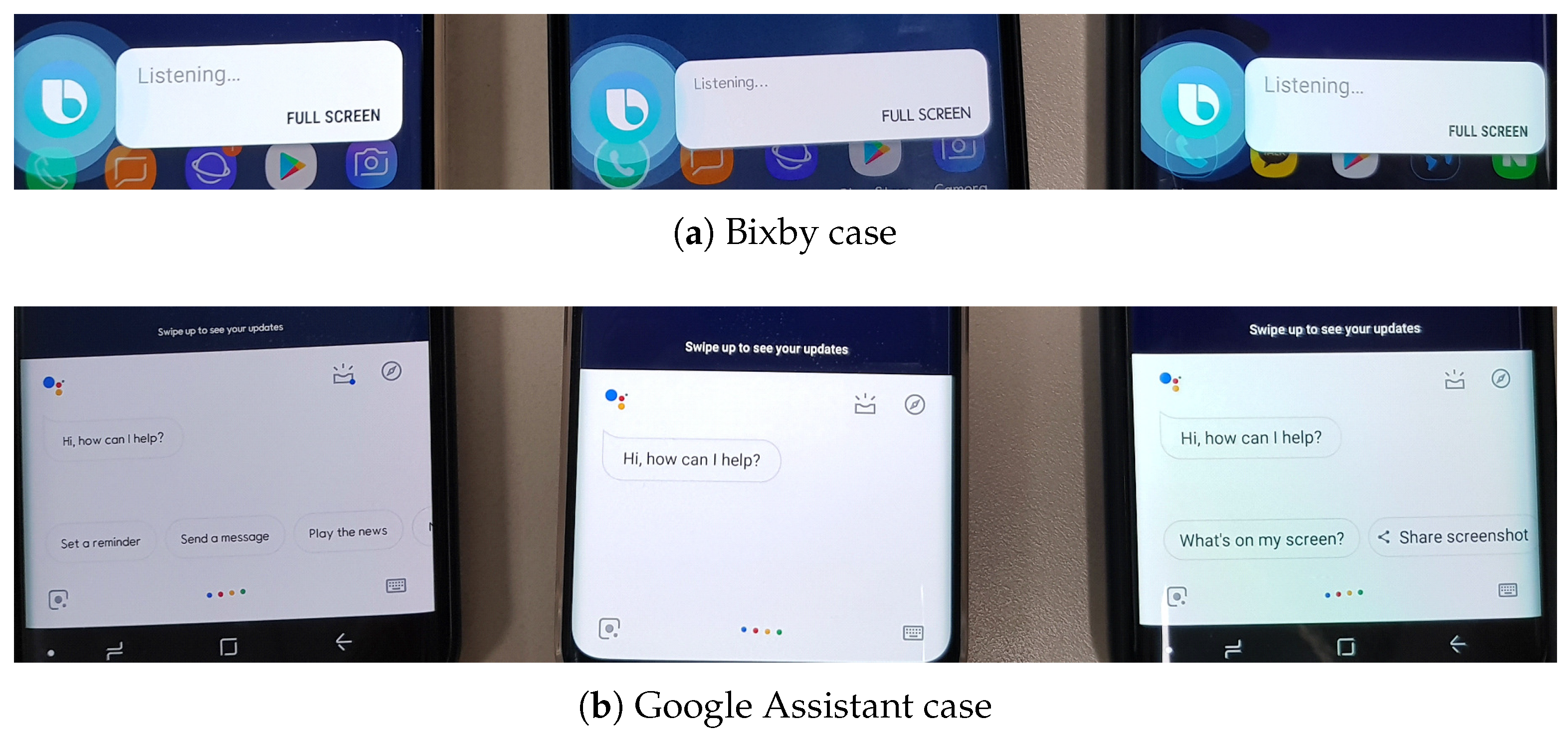



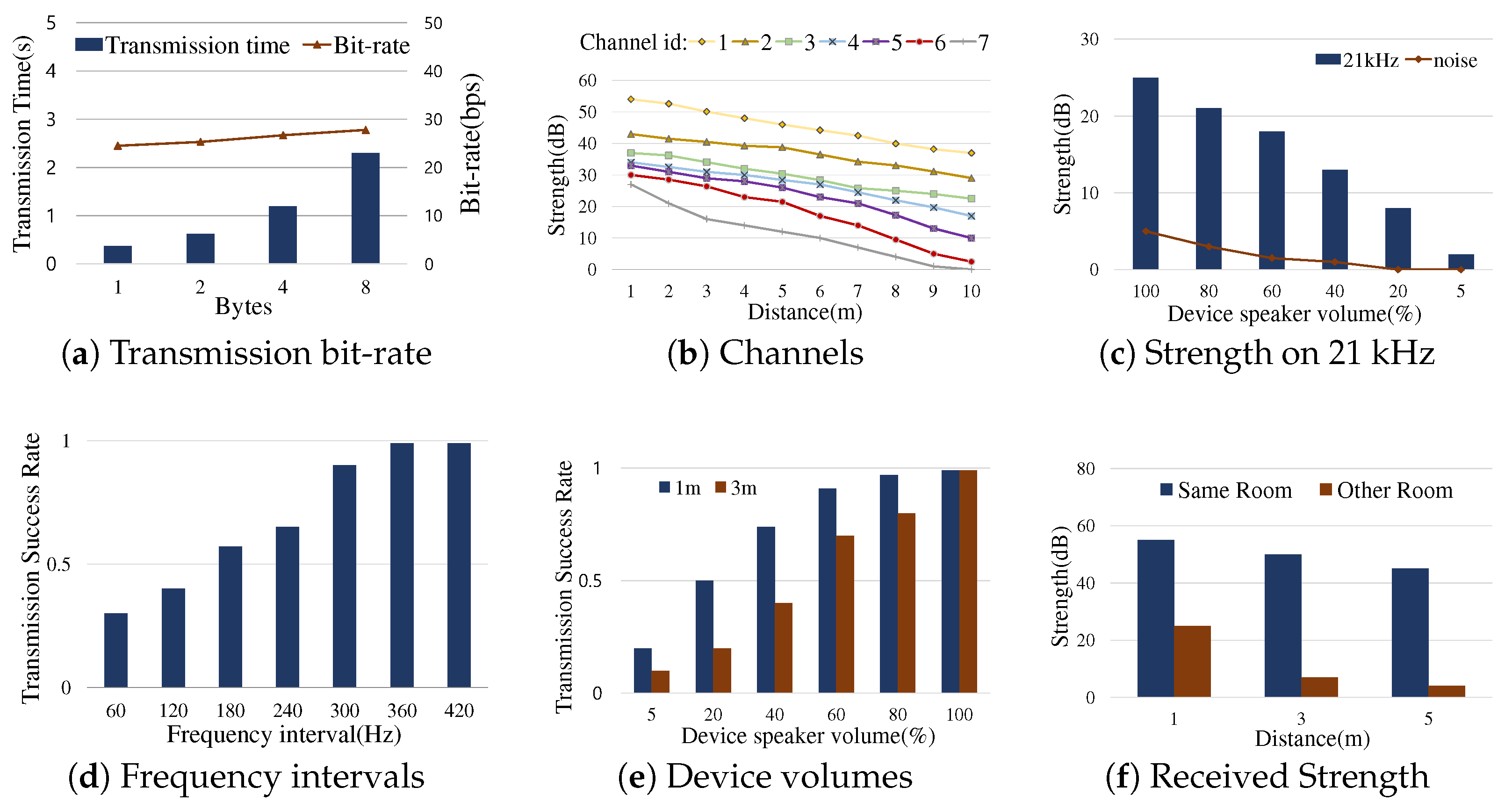
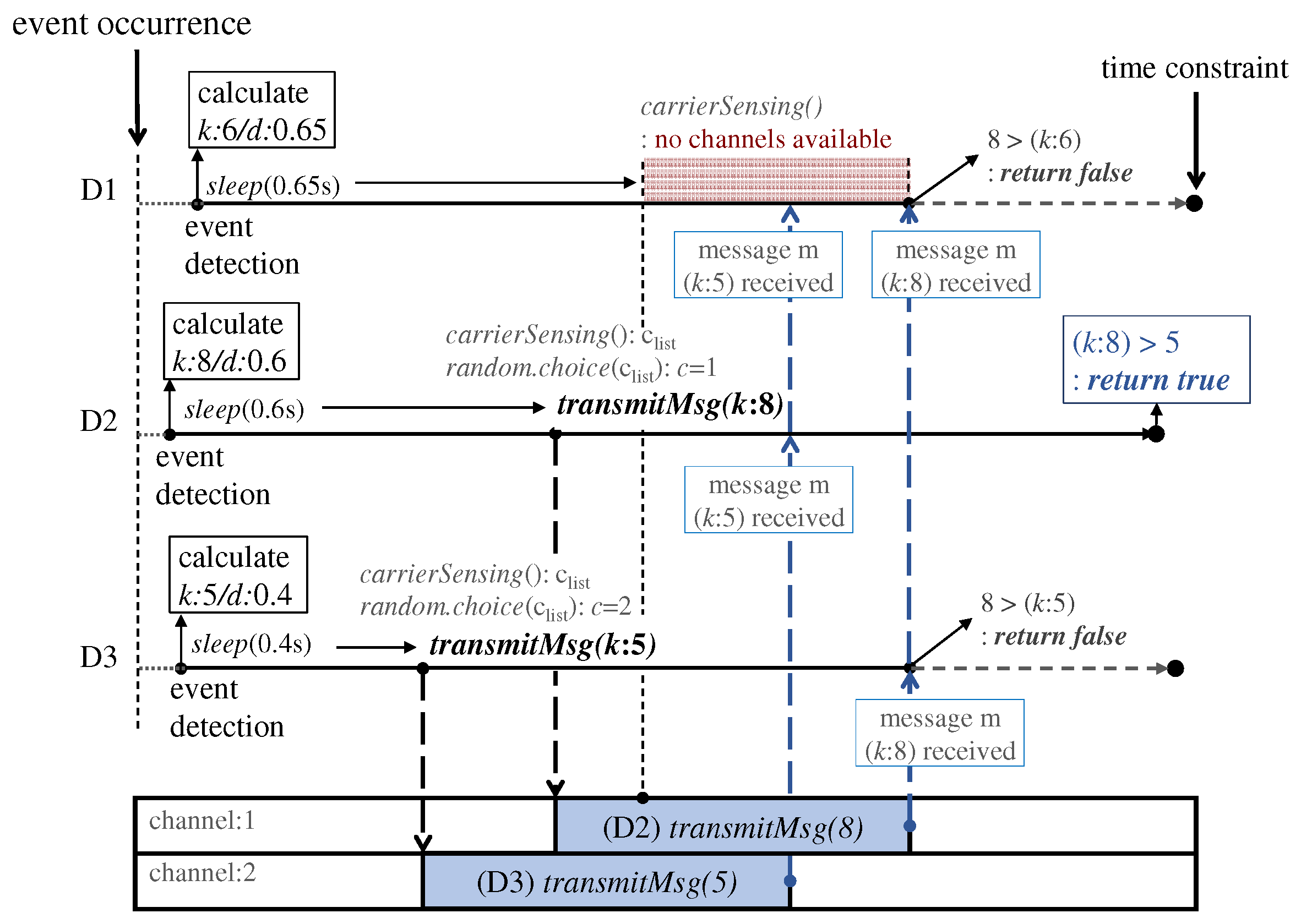

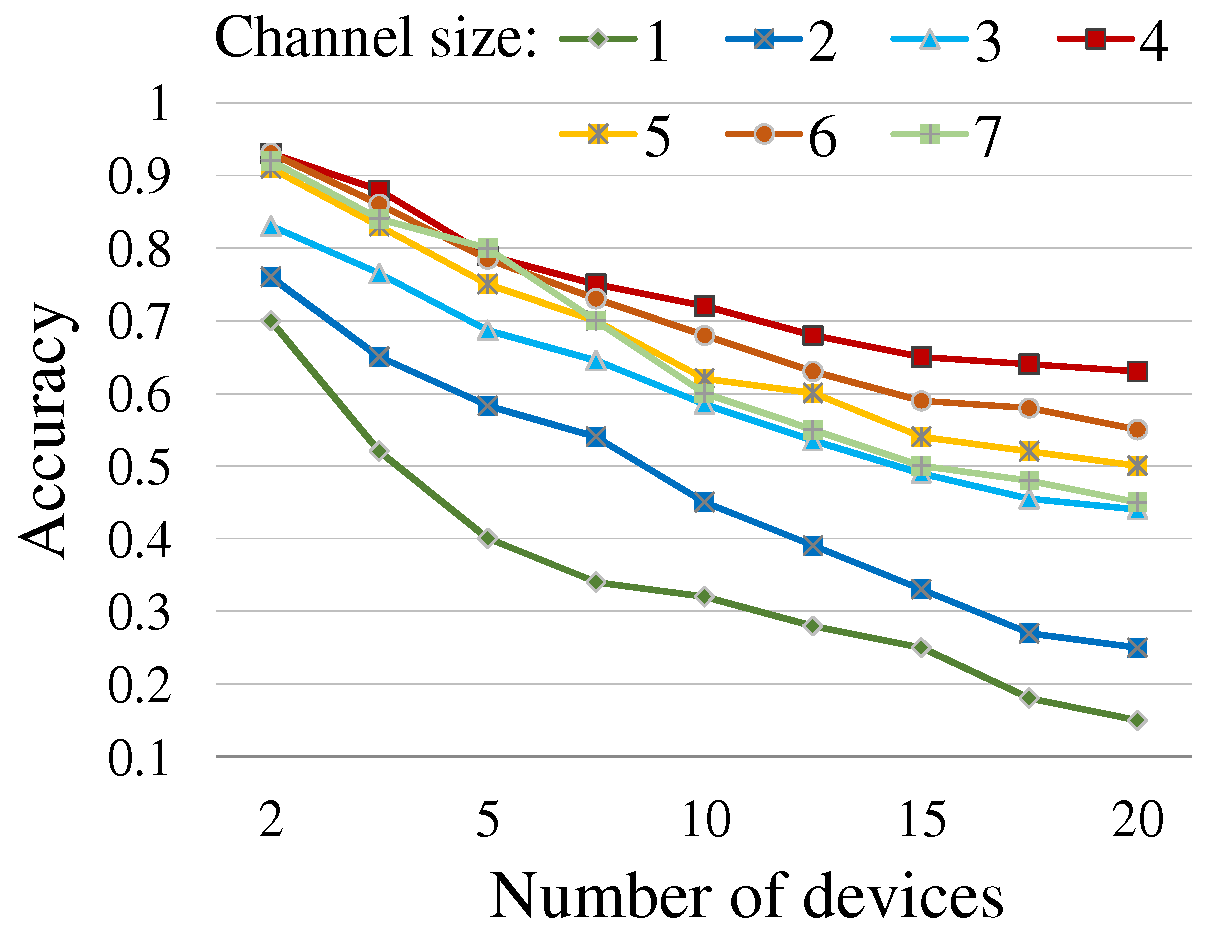


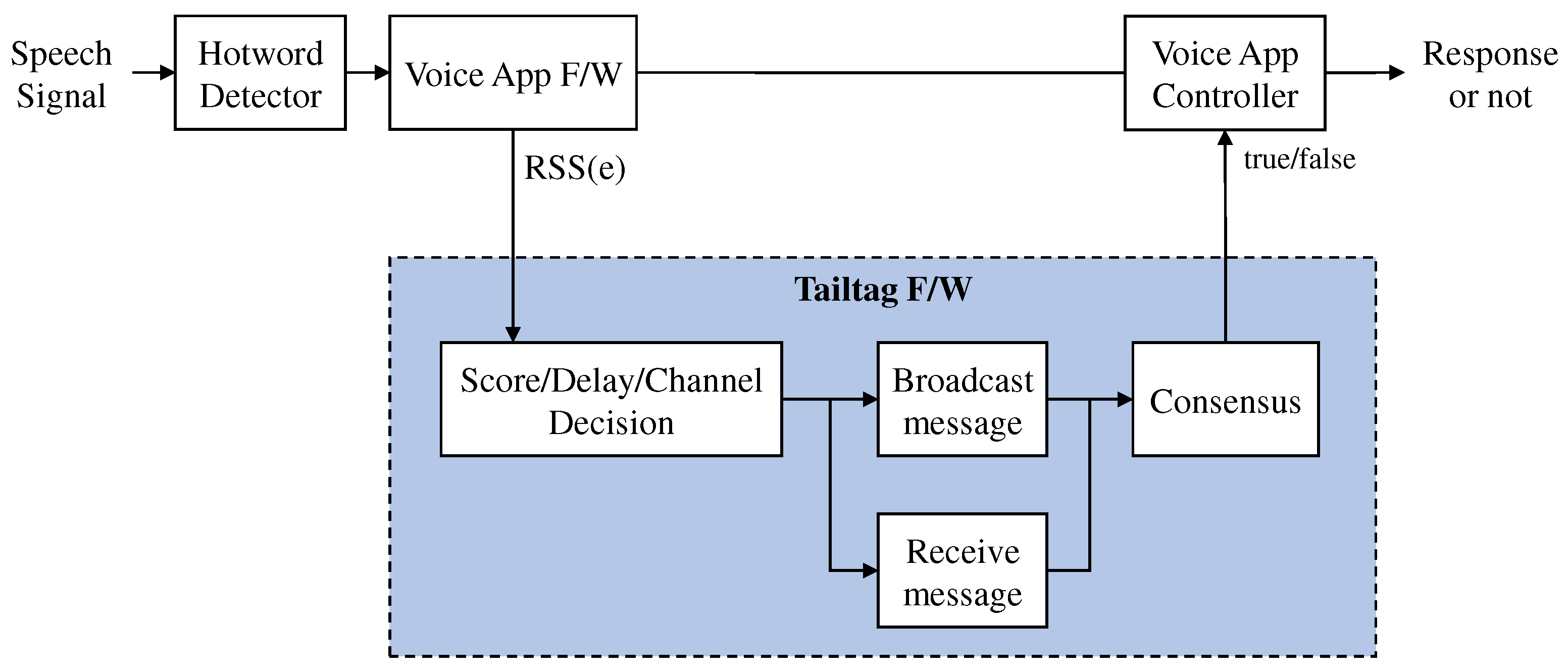
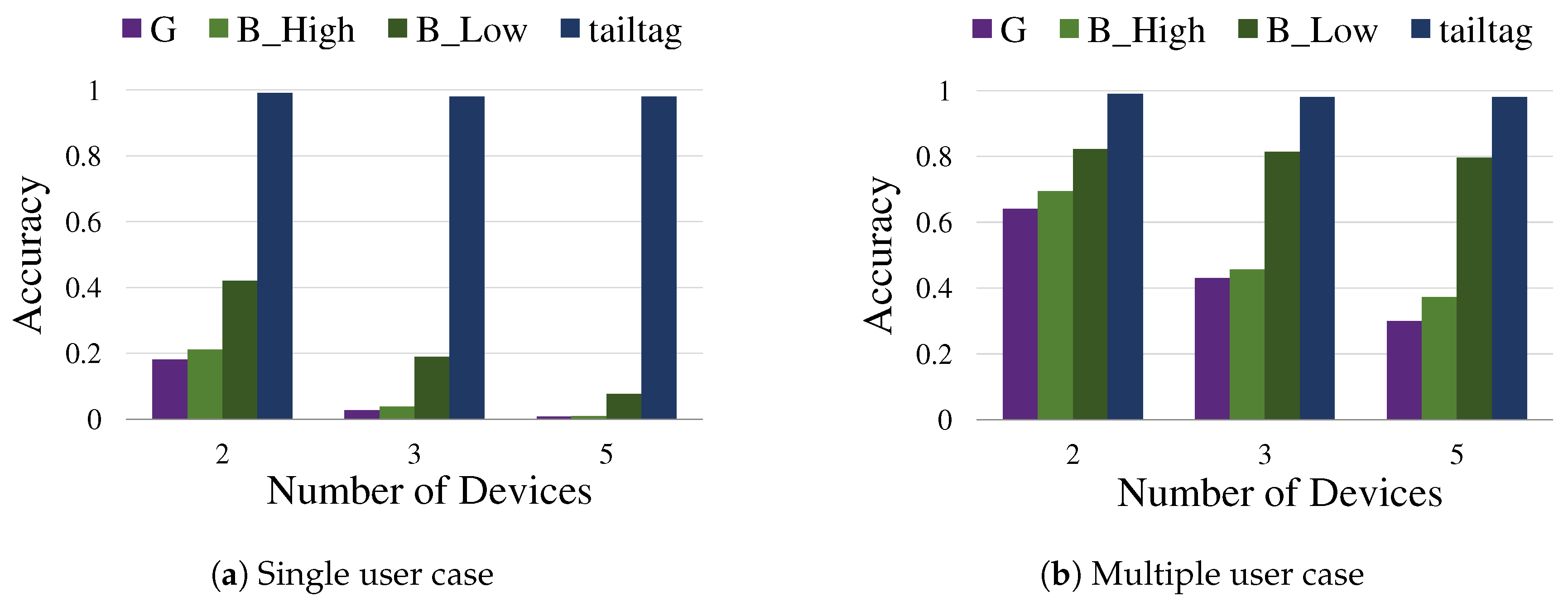
| Symbol | Definitions (Default Values) | Decided by |
|---|---|---|
| Number of available frequencies for the entire bandwidth (100) | Framework design | |
| Number of available frequencies for a guard interval (12) | Framework design | |
| Transmission time for a block (0.1 s) | Framework design | |
| Time constraint (1.1 s) | App | |
| S | Score size (10) | App |
| Event detection delay (0.1 s) | App | |
| Transmission time for a message (0.3 s) | Derivation | |
| Maximum wait delay (0.7 s) | Derivation | |
| Channel size (4) | Derivation |
| 1–4 | 2 | 0.3 s | 0.7 s |
| 5–6 | 3 | 0.4 s | 0.6 s |
| 7 | 4 | 0.5 s | 0.5 s |
| Condition | Definition | Settings |
|---|---|---|
| Event dynamics | The average number of successive event occurrences in the same location | slow = 10, medium = 5, fast = 1 |
| Group size | The number of member devices in a group | N = 5, 10, 20 |
| Group spatial density | Average distance between devices (m) | sparse = 2, medium = 1, dense = 0.5 |
© 2019 by the authors. Licensee MDPI, Basel, Switzerland. This article is an open access article distributed under the terms and conditions of the Creative Commons Attribution (CC BY) license (http://creativecommons.org/licenses/by/4.0/).
Share and Cite
Song, D.; Yeom, I.; Woo, H. Event-Triggered Ephemeral Group Communication and Coordination over Sound for Smart Consumer Devices. Sensors 2019, 19, 1883. https://doi.org/10.3390/s19081883
Song D, Yeom I, Woo H. Event-Triggered Ephemeral Group Communication and Coordination over Sound for Smart Consumer Devices. Sensors. 2019; 19(8):1883. https://doi.org/10.3390/s19081883
Chicago/Turabian StyleSong, Doohwan, Ikjun Yeom, and Honguk Woo. 2019. "Event-Triggered Ephemeral Group Communication and Coordination over Sound for Smart Consumer Devices" Sensors 19, no. 8: 1883. https://doi.org/10.3390/s19081883
APA StyleSong, D., Yeom, I., & Woo, H. (2019). Event-Triggered Ephemeral Group Communication and Coordination over Sound for Smart Consumer Devices. Sensors, 19(8), 1883. https://doi.org/10.3390/s19081883




